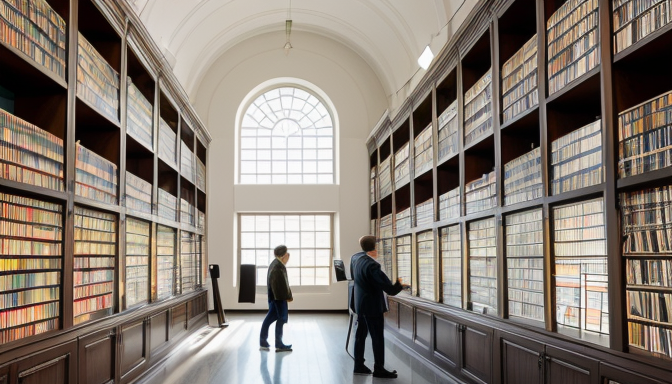Curators are the unsung heroes of our cultural heritage, working tirelessly behind the scenes to ensure that history is not just preserved, but also celebrated. Imagine walking into a museum or archive; it’s not just the artifacts that tell a story, but the passion and expertise of the curators that breathe life into them. These dedicated individuals meticulously manage collections, ensuring that every document, photograph, and artifact is safeguarded for future generations. Their work is akin to that of a time traveler, carefully preserving the echoes of the past so that we can learn from them today.
Curators are essential in safeguarding historical documents and artifacts. Their meticulous work ensures that future generations can access and learn from these valuable resources, maintaining the integrity of our collective history. They don’t just store items; they analyze, catalog, and care for them. Each piece has a story, and it’s the curator’s job to ensure that these stories are told accurately and compellingly. Think of them as the guardians of our past, wielding knowledge and skills that keep history alive.
Curators not only preserve but also promote public interest in archives. Through exhibitions and educational programs, they foster a deeper understanding of history and encourage community involvement in cultural heritage initiatives. They create immersive experiences that draw visitors in, making history relatable and engaging. It’s like they’re inviting us to join a conversation with the past, helping us to see how it shapes our present and future. Without their efforts, many stories would remain untold, lost in the shadows of time.
The Role of Curators in Preservation
Curators are the unsung heroes of the archival world, working tirelessly behind the scenes to ensure that our history is not just remembered, but preserved for future generations. Imagine a world where our past is lost to time—curators prevent that from happening. They meticulously handle historical documents and artifacts, employing their expertise to maintain the integrity of these invaluable resources. From ancient manuscripts to modern digital records, curators use a variety of techniques to protect these items from deterioration.
One of their key responsibilities is cataloging and organizing collections, which involves not just physical arrangement but also creating detailed records that make it easier for researchers and the public to access information. This process is akin to being a librarian for history, where every item tells a story waiting to be discovered. Curators also assess the condition of items, determining what needs restoration or special care. In this way, they act as both guardians and storytellers, ensuring that the narratives of our past remain vibrant and accessible.
Moreover, curators often collaborate with other professionals, such as conservators and archivists, to implement best practices in preservation. Their work is not just about keeping items safe; it’s about fostering a sense of connection to our heritage. By engaging in ongoing education and training, curators stay updated on the latest preservation techniques, ensuring that they can tackle the challenges of both physical and digital archiving.
Curators are not just the guardians of our past; they are the bridge connecting history with the present. Their work goes beyond preserving artifacts and documents; it’s about telling stories that resonate with people today. Have you ever walked into a museum and felt transported to another time? That’s the magic of a curator’s touch! They create engaging exhibitions that draw visitors in, making history feel alive and relevant.
Through innovative programming, curators foster a sense of community and invite public participation. They organize workshops, lectures, and interactive events that encourage individuals to explore their cultural heritage. For instance, a curator might host a family day where visitors can handle replicas of ancient tools or participate in storytelling sessions that bring historical figures to life. These experiences not only educate but also spark curiosity and ignite passion for history.
Moreover, curators often utilize social media and digital platforms to reach wider audiences, ensuring that historical narratives are accessible to everyone, regardless of their location. By sharing behind-the-scenes content, engaging stories, and fascinating facts, they turn passive observers into active participants in the preservation of culture. In this digital age, their role is more crucial than ever, as they harness technology to make history engaging and relevant.
In conclusion, the impact of curators on public engagement is profound. They are the storytellers, educators, and community builders who breathe life into archives, making history not just something we read about but something we experience. So, the next time you visit an exhibition, take a moment to appreciate the hard work and creativity that curators pour into their craft. They truly are the unsung heroes of our cultural heritage!

Frequently Asked Questions
- What exactly does a curator do?
A curator is like a guardian of history! They manage and preserve archives, ensuring that important documents and artifacts are kept safe for future generations. Think of them as the protectors of our cultural heritage.
- How do curators engage the public with archives?
Curators are not just behind the scenes; they actively engage the public through exhibitions, workshops, and educational programs. They make history come alive, inviting communities to explore and appreciate their cultural roots.
- Why is preserving history important?
Preserving history is crucial because it allows us to learn from the past. It helps us understand our identity and fosters a sense of connection to our roots. Without curators, many stories and lessons could be lost forever!
- How can I get involved with my local archives?
Getting involved is easier than you think! You can volunteer, attend events, or even just visit your local archives. Curators love when community members take an interest in preserving history!